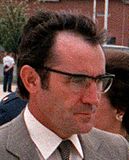Portuguese presidential election, 1980
|
|
||||||||||||||||
|---|---|---|---|---|---|---|---|---|---|---|---|---|---|---|---|---|
|
||||||||||||||||
| Turnout | 84,39% | |||||||||||||||
|
||||||||||||||||
|
||||||||||||||||
| Portugal |
 This article is part of the series: |
António Ramalho Eanes
Independent
António Ramalho Eanes
Independent
This article is part of the series:
Politics and government of
Portugal
The Portuguese presidential election of 1980 was held on 7 December.
Incumbent president General Ramalho Eanes gathered the support of the Socialist Party, despite the objection of their leader, Mário Soares, and also the support of the Portuguese Communist Party, whose candidate, Carlos Brito, withdrew the week before the election giving his support to Eanes. The Communist Party of the Portuguese Workers also gave support to Eanes, whose picture became a feature on numerous walls around the country, painted by Communist Party activists.
One of the major players in the democratic revolution of 1974, Otelo Saraiva de Carvalho, was also a candidate, for the second time, but finished far behind his previous result of 1976. The newly founded Workers Party of Socialist Unity presented its own candidate, Aires Rodrigues.
His main opponent, General Soares Carneiro, was known for his right-wing views and was branded by opponents as a hardliner, with links to the dictatotial regime overthrown only six years before. He was supported by the Democratic Alliance, a centre-right coalition comprising the Social Democratic Party the Democratic Social Center, and the smaller People's Monarchist Party.
...
Wikipedia


